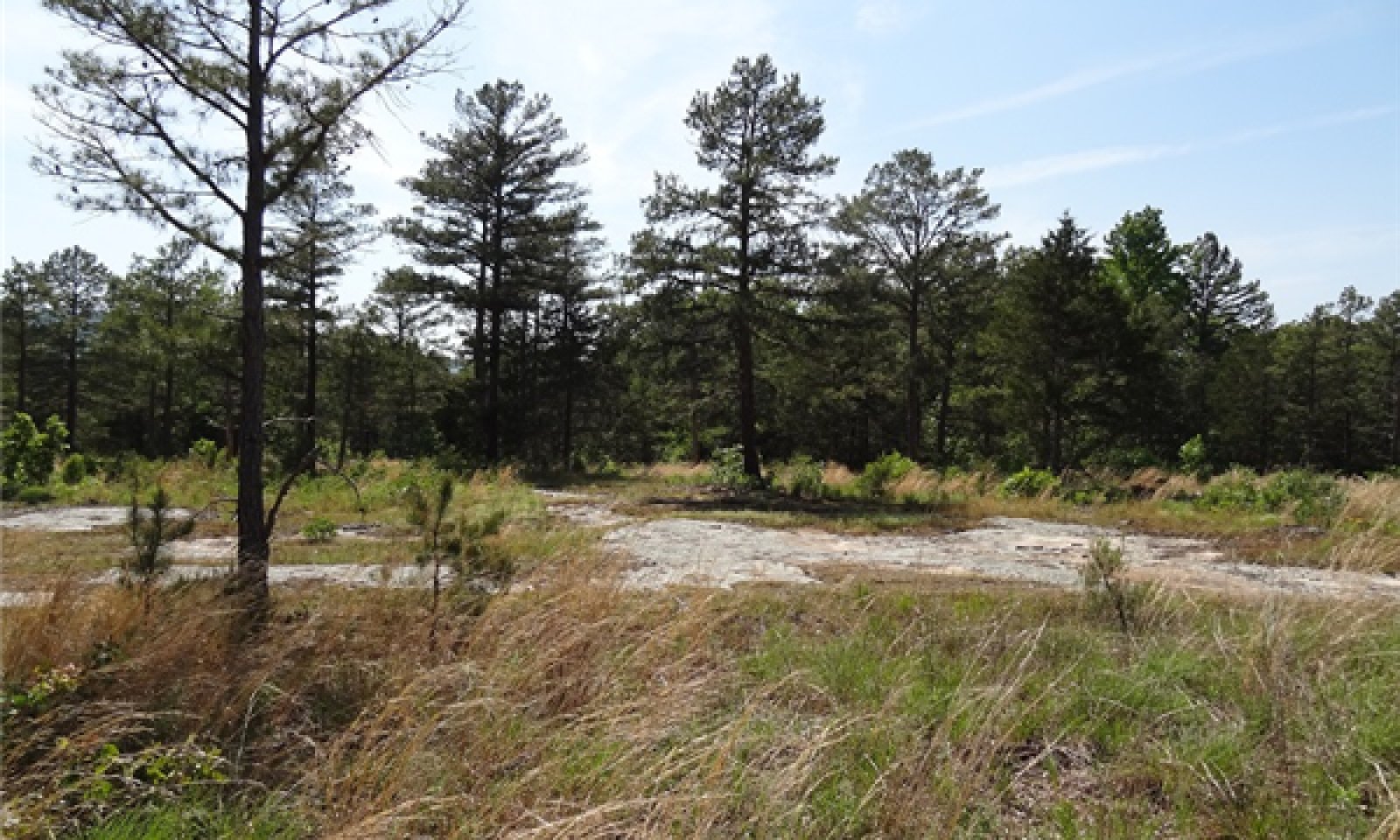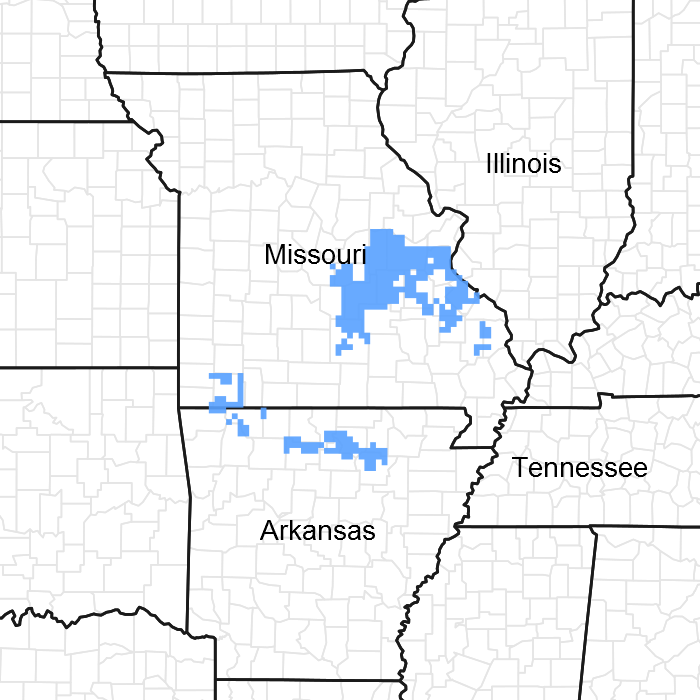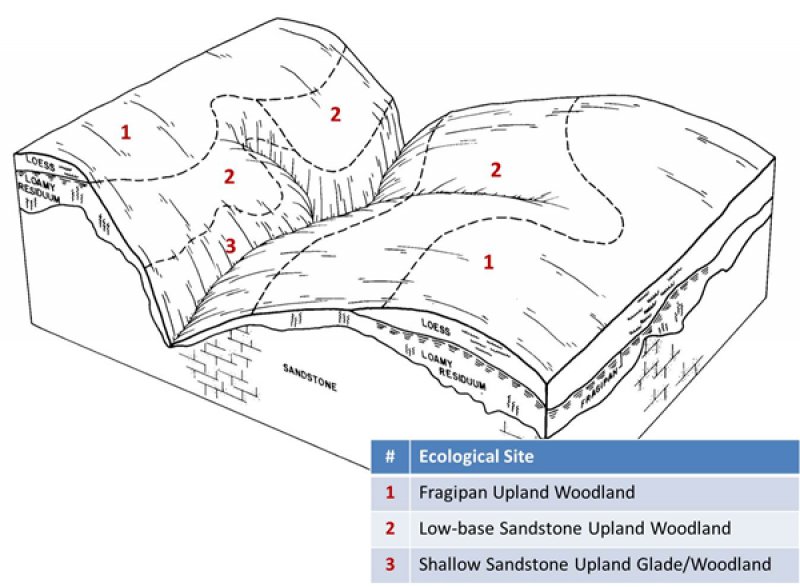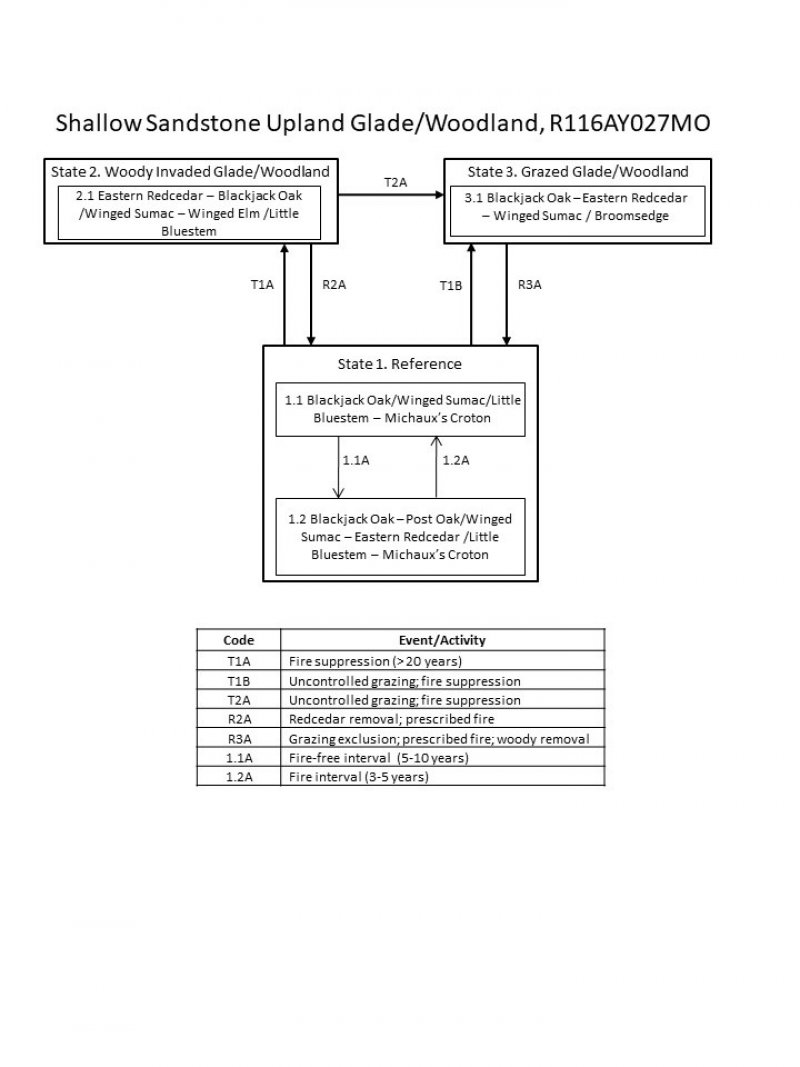

Natural Resources
Conservation Service
Ecological site R116AY027MO
Shallow Sandstone Upland Glade/Woodland
Last updated: 9/24/2020
Accessed: 12/08/2025
General information
Provisional. A provisional ecological site description has undergone quality control and quality assurance review. It contains a working state and transition model and enough information to identify the ecological site.

Figure 1. Mapped extent
Areas shown in blue indicate the maximum mapped extent of this ecological site. Other ecological sites likely occur within the highlighted areas. It is also possible for this ecological site to occur outside of highlighted areas if detailed soil survey has not been completed or recently updated.
MLRA notes
Major Land Resource Area (MLRA): 116A–Ozark Highland
The Ozark Highland constitutes the Salem Plateau of the Ozark Uplift. Elevation ranges from about 300 feet on the southeast edge of the Ozark escarpment, to about 1,600 feet in the west, adjacent to the Burlington Escarpment of the Springfield Plateau. The underlying bedrock is mainly horizontally bedded Ordovician-aged dolomites and sandstones that dip gently away from the uplift apex in southeast Missouri. Cambrian dolomites are exposed on deeply dissected hillslopes. In some places, Pennsylvanian and Mississipian sediments overlie the plateau. Relief varies, from the gently rolling central plateau areas to deeply dissected hillslopes associated with drainageways such as the Buffalo, Current, Eleven Point and White Rivers.
Classification relationships
Terrestrial Natural Community Type in Missouri (Nelson, 2010):
The reference state for this ecological site is most similar to a Sandstone Glade.
National Vegetation Classification System Vegetation Association (NatureServe, 2010):
The reference state for this ecological site is most similar to Schizachrium scoparium-Aristida dichotoma-Croton willdenowii/Lichens Wooded Herbaceous Vegetation (CEGL002242).
Geographic relationship to the Missouri Ecological Classification System (Nigh & Schroeder, 2002):
This ecological site is distributed in scattered locations of the Ozark Highlands Section (OZ).
Ecological site concept
NOTE: This is a “provisional” Ecological Site Description (ESD) that is under development. It contains basic ecological information that can be used for conservation planning, application and land management. After additional information is collected, analyzed and reviewed, this ESD will be refined and published as “Approved”.
Shallow Sandstone Upland Glade/Woodlands occur in the northeastern Ozark Highland. Soils are very shallow to sandstone bedrock. The reference plant community ranges from open areas of grasses and forbs interspersed with shallow soils and bare bedrock, to areas with shrubs and widely scattered blackjack oak.
Associated sites
| F116AY023MO |
Low-Base Sandstone Upland Woodland Low-base Sandstone Upland Woodlands are upslope, on shoulders and upper backslopes. |
|---|---|
| F116AY045MO |
Low-Base Sandstone Protected Backslope Woodland Low-base Sandstone Protected Backslope Woodlands are adjacent and downslope, on steep lower backslopes with northern to eastern exposures. |
| F116AY053MO |
Low-Base Sandstone Exposed Backslope Woodland Low-base Sandstone Exposed Backslope Woodlands are adjacent and downslope, on steep lower backslopes with southern to western exposures. |
Similar sites
| R116AY020MO |
Shallow Dolomite Upland Glade/Woodland Shallow Dolomite Upland Glade/Woodland has similar landscape features and community structure but has dolomite as a bedrock gelogy. |
|---|
Table 1. Dominant plant species
| Tree |
(1) Quercus marilandica |
|---|---|
| Shrub |
(1) Rhus copallina |
| Herbaceous |
(1) Schizachyrium scoparium |
Physiographic features
This site is on upland crests, shoulders and backslopes with slopes of 3 to 35 percent. The site generates runoff to adjacent, downslope ecological sites. This site does not flood.
The following figure (adapted from Brown and Childress, 1985) shows the typical landscape position of this ecological site, and landscape relationships with other ecological sites. It is within the area labeled “3” on the figure. Shallow Sandstone Upland Glade/Woodland sites are typically associated with Low-base Sandstone Upland Woodland sites, labeled “2”.

Figure 2. Landscape relationships for this ecological site.
Table 2. Representative physiographic features
| Landforms |
(1)
Ridge
(2) Interfluve (3) Hill (4) Hillslope |
|---|---|
| Flooding frequency | None |
| Ponding frequency | None |
| Slope | 3 – 50% |
| Water table depth | 60 in |
| Aspect | W, SE, S, SW |
Climatic features
The Ozark Highland has a continental type of climate marked by strong seasonality. In winter, dry-cold air masses, unchallenged by any topographic barriers, periodically swing south from the northern plains and Canada. If they invade reasonably humid air, snowfall and rainfall result. In summer, moist, warm air masses, equally unchallenged by topographic barriers, swing north from the Gulf of Mexico and can produce abundant amounts of rain, either by fronts or by convectional processes. In some summers, high pressure stagnates over the region, creating extended droughty periods. Spring and fall are transitional seasons when abrupt changes in temperature and precipitation may occur due to successive, fast-moving fronts separating contrasting air masses.
The Ozark Highland experiences regional differences in climates, but these differences do not have obvious geographic boundaries. Regional climates grade inconspicuously into each other. The basic gradient for most climatic characteristics is along a line crossing the MLRA from northwest to southeast.
The average annual precipitation in almost all of this area is 38 to 45 inches. Snow falls nearly every winter, but the snow cover lasts for only a few days. The average annual temperature is about 53 to 60 degrees F. The lower temperatures occur at the higher elevations in the western part of the MLRA. Mean January minimum temperature follows a stronger north-to-south gradient. However, mean July maximum temperature shows hardly any geographic variation in the MLRA. Mean July maximum temperatures have a range of only two or three degrees across the area.
Mean annual precipitation varies along a northwest to southeast gradient. Seasonal climatic variations are more complex. Seasonality in precipitation is very pronounced due to strong continental influences. June precipitation, for example, averages three to four times greater than January precipitation. Most of the rainfall occurs as high-intensity, convective thunderstorms in summer.
During years when precipitation comes in a fairly normal manner, moisture is stored in the top layers of the soil during the winter and early spring, when evaporation and transpiration are low. During the summer months the loss of water by evaporation and transpiration is high, and if rainfall fails to occur at frequent intervals, drought will result. Drought directly affects plant and animal life by limiting water supplies, especially at times of high temperatures and high evaporation rates.
Superimposed upon the basic MLRA climatic patterns are local topographic influences that create topoclimatic, or microclimatic variations. In regions of appreciable relief, for example, air drainage at nighttime may produce temperatures several degrees lower in valley bottoms than on side slopes. At critical times during the year, this phenomenon may produce later spring or earlier fall freezes in valley bottoms. Deep sinkholes often have a microclimate significantly cooler, moister, and shadier than surrounding surfaces, a phenomenon that may result in a strikingly different ecology. Higher daytime temperatures of bare rock surfaces and higher reflectivity of these unvegetated surfaces may create distinctive environmental niches such as glades and cliffs.
Slope orientation is an important topographic influence on climate. Summits and south-and-west-facing slopes are regularly warmer and drier than adjacent north- and-east-facing slopes. Finally, the climate within a canopied forest is measurably different from the climate of a more open grassland or savanna areas.
Source: University of Missouri Climate Center - http://climate.missouri.edu/climate.php; Land Resource Regions and Major Land Resource Areas of the United States, the Caribbean, and the Pacific Basin, United States Department of Agriculture Handbook 296 - http://soils.usda.gov/survey/geography/mlra/
Table 3. Representative climatic features
| Frost-free period (characteristic range) | 148-150 days |
|---|---|
| Freeze-free period (characteristic range) | 176-186 days |
| Precipitation total (characteristic range) | 45-48 in |
| Frost-free period (actual range) | 147-151 days |
| Freeze-free period (actual range) | 172-188 days |
| Precipitation total (actual range) | 45-49 in |
| Frost-free period (average) | 149 days |
| Freeze-free period (average) | 181 days |
| Precipitation total (average) | 47 in |
Figure 3. Monthly precipitation range
Figure 4. Monthly minimum temperature range
Figure 5. Monthly maximum temperature range
Figure 6. Monthly average minimum and maximum temperature
Figure 7. Annual precipitation pattern
Figure 8. Annual average temperature pattern
Climate stations used
-
(1) UNION [USC00238515], Union, MO
-
(2) EVENING SHADE 1 NNE [USC00032366], Evening Shade, AR
-
(3) FARMINGTON [USC00232809], Farmington, MO
Influencing water features
High temperatures, intense solar radiation, and dry conditions prevail throughout much of the growing season, although soils may be saturated in spring, winter and late fall. Frost upheaval frequently disrupts these shallow soils during the dominant season. While evapotranspiration remains the most constant water feature, evapotranspiration rates typically peak in the summer and becomes the dominant water feature. The surface runoff pulse is greatly influenced by extreme events.
Soil features
These soils are underlain by sandstone bedrock at less than 20 inches. The soils were formed under a mixture of grasses, forbs, and woodlands. Organic matter content is variable, but is generally low. Parent material is sandstone residuum. They have fine sandy loam or loam surface layers, with loamy subsoils. Low to moderate amounts of sandstone fragments are in some soils. They are not affected by seasonal wetness. Soil series associated with this site include Ramsey.
Table 4. Representative soil features
| Parent material |
(1)
Residuum
–
sandstone
|
|---|---|
| Surface texture |
(1) Loam (2) Fine sandy loam |
| Family particle size |
(1) Loamy |
| Drainage class | Well drained to somewhat excessively drained |
| Permeability class | Moderate |
| Soil depth | 4 – 20 in |
| Surface fragment cover <=3" | 10% |
| Surface fragment cover >3" | 1% |
| Available water capacity (0-40in) |
2 – 3 in |
| Calcium carbonate equivalent (0-40in) |
Not specified |
| Electrical conductivity (0-40in) |
2 mmhos/cm |
| Sodium adsorption ratio (0-40in) |
Not specified |
| Soil reaction (1:1 water) (0-40in) |
4.5 – 6.5 |
| Subsurface fragment volume <=3" (Depth not specified) |
20% |
| Subsurface fragment volume >3" (Depth not specified) |
10% |
Ecological dynamics
Information contained in this section was developed using historical data, professional experience, field reviews, and scientific studies. The information presented is representative of very complex vegetation communities. Key indicator plants, animals and ecological processes are described to help inform land management decisions. Plant communities will differ across the MLRA because of the naturally occurring variability in weather, soils, and aspect. The Reference Plant Community is not necessarily the management goal. The species lists are representative and are not botanical descriptions of all species occurring, or potentially occurring, on this site. They are not intended to cover every situation or the full range of conditions, species, and responses for the site.
Glades are open, rocky areas with very shallow soils dominated by drought-adapted herbaceous flora, generally occurring on south-and west-facing slopes of otherwise wooded sites. The shallow soils of this ecological site limit the growth and abundance of trees and support the native grasses and forbs that dominate these systems. The following conditions are general characteristic of most sandstone glades (Nelson and Ladd 1983; Nelson et al. 2013):
• Sandstone bedrock at or near the surface because of major erosional activity and resistance to weathering;
• Moderate to steep slopes in deeply dissected drainages or hilly to mountainous terrain with a southern or western exposure with intense solar radiation;
• Extremely thin soil cover interspersed with abundant rock fragments and rock outcrops;
• Exceptionally dry conditions throughout much of the growing season, although soils may be seasonally saturated in spring, winter, and fall;
• Peripheral areas and sometimes large expanses of the glades themselves characterized by a mosaic of stunted, often gnarled trees and shrubs.
Shallow Sandstone Upland Glade/Woodlands harbor a wide diversity of lichens, plants and animals. The dominant grasses include little bluestem1, broomsedge and Indiangrass. The glade/woodland complexes range from wide open grassy areas with very shallow soils and bare bedrock, to areas with widely scattered blackjack oaks on slightly deeper soils and more protected slopes.
Trees found on and near glades are often stunted and express poor development because of shallow droughty soils and poor growing conditions. Like the adjacent prairies, fire also played an important role in the maintenance of these systems. These systems typically burned at least once every three years. These periodic fires removed the litter and stimulated the growth and flowering of the grasses and forbs. They also further limited the growth and dominance of trees. Fire tolerant blackjack oak occupied islands and edges of deeper soils, creating a complex mosaic of open glade and low-density woodland.
During fire-free intervals, woody species increased, especially on protected slopes. Once established, blackjack oak, eastern redcedar and sumac can quickly fill in a glade/woodland system, especially if grazing has diminished the vigor of the diverse flora. Many glades have been heavily grazed and suffer substantial woody invasion. Removal of the undesirable woody plants and the application of prescribed fire have proven to be effective management tools.
A state-and-transition diagram follows. Detailed descriptions of each state, transition, plant community, and pathway follow the model. This model is based on available experimental research, field observations, professional consensus, and interpretations. It is likely to change as knowledge increases.
State and transition model

Figure 9. State and Transition Model for this ecological site
More interactive model formats are also available.
View Interactive Models
More interactive model formats are also available.
View Interactive Models
Click on state and transition labels to scroll to the respective text
Ecosystem states
State 2 submodel, plant communities
State 3 submodel, plant communities
State 1
Reference
The historic Shallow Sandstone Upland Glade/Woodland reference site harbors a wide diversity of plants and animals. Many, like little bluestem, Indiangrass, and sideoats grama, are also found on prairies. The glade/woodland complexes range from wide open grassy areas with shallower soil profiles and bare bedrock, to areas with widely scattered blackjack oak and post oak on locations with soil depths at the deeper extreme of the range for this soil component. On protected slopes, open woodlands are more common. Here the deeper soil depth range for this soil component and protected aspects allow more woody components to dominate. Shortleaf pine can dominate on some sites.
Community 1.1
Blackjack Oak/Winged Sumac/Little Bluestem – Michaux’s Croton

Figure 10. Sandstone glade complex reference state in the Arkansas White River watershed - shortleaf pine variant; photo credit Doug Wallace, NRCS
These systems typically burned at least once every three years. These periodic fires removed the litter and stimulated the growth and flowering of the grasses and forbs. They also further limited the growth and dominance of trees.
Forest overstory. The Overstory Species list is based on field surveys and commonly occurring species listed in Nelson (2010).
Forest understory. The Understory Species list is based on field surveys and commonly occurring species listed in Nelson (2010).
Community 1.2
Blackjack Oak – Post Oak/Winged Sumac – Eastern Redcedar /Little Bluestem – Michaux’s Croton
During fire-free intervals, woody species increased, especially on protected slopes.
Pathway P1.1A
Community 1.1 to 1.2
Fire-free interval (5-10 years)
Pathway P1.2A
Community 1.2 to 1.1
Fire interval (3-5 years)
State 2
Woody invaded Glade/Woodland
This state is dominated by eastern redcedar with large increases of oak density due to extended periods of fire suppression. This state can form relatively even-age stands, dating to when fire suppression became the dominant management characteristic on the site. Canopy closures can approach 100 percent with little or no ground flora. Transition back to the reference state may require a number of prescribed fire events and thinning out of excess woody species. This state also can transition to a grazed state (State 3) with the introduction of domestic livestock.
Community 2.1
Eastern Redcedar-Blackjack Oak/Winged Sumac-Winged Elm/Little Bluestem
State 3
Grazed Glade/Woodland
The Grazed Glade/Woodland State has reduced cover, diversity and vigor of native glade/woodland flora. Woody species encroachment, particularly by eastern redcedar, has also increased in this state. Potential physical site damage by uncontrolled livestock grazing may further degrade this state.
Community 3.1
Blackjack Oak-Eastern Redcedar-Winged Sumac/Broomsedge
Transition T1A
State 1 to 2
Fire suppression (> 20 years)
Transition T1B
State 1 to 3
Uncontrolled grazing; fire suppression
Restoration pathway R2A
State 2 to 1
Redcedar removal; prescribed fire
Transition T2A
State 2 to 3
Uncontrolled grazing; fire suppression
Restoration pathway R3A
State 3 to 1
Grazing exclusion; prescribed fire; woody removal
Additional community tables
Table 5. Community 1.1 forest overstory composition
| Common name | Symbol | Scientific name | Nativity | Height (ft) | Canopy cover (%) | Diameter (in) | Basal area (square ft/acre) |
|---|---|---|---|---|---|---|---|
|
Tree
|
|||||||
| post oak | QUST | Quercus stellata | Native | – | – | – | – |
| blackjack oak | QUMA3 | Quercus marilandica | Native | – | – | – | – |
| eastern redcedar | JUVI | Juniperus virginiana | Native | – | – | – | – |
| shortleaf pine | PIEC2 | Pinus echinata | Native | – | – | – | – |
Table 6. Community 1.1 forest understory composition
| Common name | Symbol | Scientific name | Nativity | Height (ft) | Canopy cover (%) | |
|---|---|---|---|---|---|---|
|
Grass/grass-like (Graminoids)
|
||||||
| purple lovegrass | ERSP | Eragrostis spectabilis | Native | – | – | |
| sixweeks fescue | VUOC | Vulpia octoflora | Native | – | – | |
| lopsided rush | JUSE | Juncus secundus | Native | – | – | |
| broomsedge bluestem | ANVI2 | Andropogon virginicus | Native | – | – | |
| tapered rosette grass | DIAC2 | Dichanthelium acuminatum | Native | – | – | |
| Indiangrass | SONU2 | Sorghastrum nutans | Native | – | – | |
| Great Plains flatsedge | CYLU2 | Cyperus lupulinus | Native | – | – | |
| little bluestem | SCSC | Schizachyrium scoparium | Native | – | – | |
| poverty oatgrass | DASP2 | Danthonia spicata | Native | – | – | |
|
Forb/Herb
|
||||||
| Michaux's croton | CRMIE | Croton michauxii var. ellipticus | Native | – | – | |
| Virginia tephrosia | TEVI | Tephrosia virginiana | Native | – | – | |
| scaly blazing star | LISQ | Liatris squarrosa | Native | – | – | |
| roundstem false foxglove | AGGA | Agalinis gattingeri | Native | – | – | |
| mealy fumewort | COCR2 | Corydalis crystallina | Native | – | – | |
| hairy pinweed | LEMU3 | Lechea mucronata | Native | – | – | |
| orangegrass | HYGE | Hypericum gentianoides | Native | – | – | |
| fringeleaf wild petunia | RUHU | Ruellia humilis | Native | – | – | |
| dwarf plantain | PLPU | Plantago pusilla | Native | – | – | |
| poorjoe | DITE2 | Diodia teres | Native | – | – | |
| Virginia dwarfdandelion | KRVI | Krigia virginica | Native | – | – | |
| southern bluet | HOMI4 | Houstonia micrantha | Native | – | – | |
| common dittany | CUOR | Cunila origanoides | Native | – | – | |
| hairy pinweed | LEMU3 | Lechea mucronata | Native | – | – | |
|
Fern/fern ally
|
||||||
| hairy lipfern | CHLA2 | Cheilanthes lanosa | Native | – | – | |
|
Shrub/Subshrub
|
||||||
| fragrant sumac | RHAR4 | Rhus aromatica | Native | – | – | |
| winged elm | ULAL | Ulmus alata | Native | – | – | |
| winged sumac | RHCO | Rhus copallinum | Native | – | – | |
|
Tree
|
||||||
| farkleberry | VAAR | Vaccinium arboreum | Native | – | – | |
|
Nonvascular
|
||||||
| Schleicher's cracked lichen | ACSC5 | Acarospora schleicheri | Native | – | – | |
| greygreen reindeer lichen | CLRA60 | Cladina rangiferina | Native | – | – | |
| cup lichen | CLMA17 | Cladonia mateocyatha | Native | – | – | |
| northern selaginella | SERU | Selaginella rupestris | Native | – | – | |
Interpretations
Animal community
Wildlife*
Wildlife habitat: oaks provide hard mast; numerous native legumes provide high-quality wildlife food; native warm-season grasses provide extensive cover and nesting habitat; and a diversity of forbs provides a diversity and abundance of insects. Post-burn areas can provide temporary bare-ground – herbaceous cover habitat important for turkey poults and quail chicks.
Game species that utilize this ecological site include:
Northern Bobwhite will utilize this ecological site for food (seeds, insects), cover needs (escape, nesting and roosting cover) and brood-rearing habitat.
Cottontail rabbits will utilize this ecological site for food (seeds, soft mast) and cover needs.
Turkey will utilize this ecological site for food (seeds, green browse, soft mast, and insects) and nesting and brood-rearing cover. Turkey poults feed heavily on insects provided by this site type.
White-tailed deer will utilize this ecological site for browse (plant leaves in the growing season, seeds and soft mast in the fall/winter). This site type also can provide escape cover.
Bird species associated with this ecological site’s reference state condition:
Breeding Birds: Field Sparrow, Yellow-breasted Chat, Blue-winged Warbler, Brown Thrasher, Indigo Bunting, Red-headed Woodpecker, Eastern Bluebird, Northern Bobwhite, Summer Tanager and Eastern Wood-Pewee.
Amphibian and reptile species that may be associated with this ecological site’s reference state: five-lined skink (Eumeces fasciatus), six-lined racerunner (Cnemidophorus sexlineatus), flat-headed snake (Tantilla gracilis), eastern coachwhip (Masticophis flagellum flagellum), red milk snake (Lampropeltis triangulum syspila), ground snake (Snora semiannulata) and prairie ring-necked snake (Diadophis punctatus arnyi).
Small mammals likely associated with this ecological site’s reference state condition: eastern woodrat (Neotoma floridana) and peromyscus species.
Invertebrates – Many native insect species are likely associated with this phase of this ecological site’s reference state condition, especially native bees, ants, beetles, butterflies and moths, and crickets, grasshoppers and katydids.
Insect species likely associated with this ecological site’s reference state condition: lichen grasshopper (Trimerotropis saxatilis), a prickly pear borer moth (Melitara prodenialis), native ants (Pheidole tysoni, Formica schaufussi), and native bees (Colletes aestivalis, Andrena helianthiformis, Protandrena rudbeckiae, Lasioglossum coreopsis, Anthidium psoraleae and Dianthidium subrufulum).
*This section prepared by Mike Leahy, Natural Areas Coordinator, Missouri Department of Conservation, 2013. References for this section: Fitzgerald and Pashley 2000a; Heitzman and Heitzman 1996; Jacobs 2001; Johnson 2000; Pitts and McGuire 2000; Schwartz and others 2001.
Other information
Forestry (NRCS 2002):
Management: Estimated site index values are less than 30 for eastern redcedar and generally less than 40 for oak. Productivity is very low. Very limited to no timber management opportunities exist. These sites are valuable for wildlife purposes and watershed protection. Severely reduced rooting depth restricts tree growth and increases windthrow hazards. These sites respond well to prescribed fire as a management tool.
Limitations: Surface stones and surface rock; very shallow soil depth. Surface stones and rocks are problems for efficient and safe equipment operation. Severe seedling mortality due to high soil surface temperatures and low available water holding capacity is possible. Machine planting and mechanical site preparation is not recommended. Hard bedrock at shallow depths may interfere with equipment operation. Rock outcrops may cause breakage of timber when harvesting. Surface stones and rocks will make equipment use extremely difficult. Erosion is a hazard when slopes exceed 15 percent. On steep slopes greater than 35 percent, traction problems increase and equipment use is not recommended.
Supporting information
Inventory data references
Potential Reference Sites: Shallow Sandstone Upland Glade/Woodland
Plot HATOSP04 – Ramsey soil
Located in HaHa Tonka State Park, Camden County, MO
Latitude: 37.962839
Longitude: -92.76537
Plot PISPNA01 – Ramsey soil
Located in Pickle Springs Natural Area, Ste. Genevieve County, MO
Latitude: 37.800845
Longitude: -90.29966
Plot HAWNSP01 – Ramsey soil
Located in Hawn State Park, Ste. Genevieve County, MO
Latitude: 37.84502
Longitude -91.12541278
Plot HAWNSP02 – Ramsey soil
Located in Hawn State Park, Ste. Genevieve County County, MO
Latitude: 37.82683
Longitude: -90.23235096
Other references
Anderson, R.C. 1990. The historic role of fire in North American grasslands. Pp. 8-18 in S.L. Collins and L.L. Wallace (eds.). Fire in North American tallgrass prairies. University of Oklahoma Press, Norman.
Batek, M.J., A.J. Rebertus, W.A. Schroeder, T.L. Haithcoat, E. Compas, and R.P. Guyette. 1999. Reconstruction of early nineteenth-century vegetation and fire regimes in the Missouri Ozarks. Journal of Biogeography 26:397-412.
Brown, Burton L., and James D. Childress. 1985. Soil Survey of Ste. Genevieve County, Missouri. U.S. Dept. of Agric. Soil Conservation Service.
Fitzgerald, J.A. and D.N. Pashley. 2000a. Partners in Flight bird conservation plan for the Ozark/Ouachitas. American Bird Conservancy.
Fitzgerald, J.A. and D.N. Pashley. 2000b. Partners in Flight bird conservation plan for the Dissected Till Plains. American Bird Conservancy.
Harlan, J.D., T.A. Nigh and W.A. Schroeder. 2001. The Missouri original General Land Office survey notes project. University of Missouri, Columbia.
Heitzman, J.R. and J.E. Heitzman. 1996. Butterflies and moths of Missouri. 2nd ed. Missouri Department of Conservation, Jefferson City.
Jacobs, B. 2001. Birds in Missouri. Missouri Department of Conservation, Jefferson City.
Johnson, T.R. 2000. The amphibians and reptiles of Missouri. 2nd ed. Missouri Department of Conservation, Jefferson City.
Nelson, Paul W. 2010. The Terrestrial Natural Communities of Missouri. Missouri Department of Conservation, Jefferson City, Missouri. 550p.
Nelson, Paul W and Douglas Ladd. 1980. “Preliminary report on the identification, distribution and classification of Missouri glades”. C.L. Kucera, Editor, in Proceedings of the Seventh North American Prairie Conference, SW Missouri State Univ. p. 59-76.
Nelson, P. W., J. A. Fitzgerald, K. Larson, R. McCoy, A. Schotz, J. Taft, T. Witsell, B. Yahn. 2013. Central Hardwoods Joint Venture Glade Conservation Assessment for the Interior Highlands and Interior Low Plateaus of the Central Hardwoods Region. Central Hardwoods Joint Venture.
Nigh, Timothy A., and Walter A. Schroeder. 2002. Atlas of Missouri Ecoregions. Missouri Department of Conservation, Jefferson City, Missouri. 212p.
Pitts, D.E. and W.D. McGuire. 2000. Wildlife management for Missouri landowners. 3rd ed. Missouri Department of Conservation, Jefferson City.
Schoolcraft, H.R. 1821. Journal of a tour into the interior of Missouri and Arkansas from Potosi, or Mine a Burton, in Missouri territory, in a southwest direction, toward the Rocky Mountains: performed in the years 1818 and 1819. Richard Phillips and Company, London.
Schwartz, C.W., E.R. Schwartz and J.J. Conley. 2001. The wild mammals of Missouri. University of Missouri Press, Columbia and Missouri Department of Conservation, Jefferson City.
United States Department of Agriculture – Natural Resource Conservation Service (USDA-NRCS). 2006. Land Resource Regions and Major Land Resource Areas of the United States, the Caribbean, and the Pacific Basin. U.S. Department of Agriculture Handbook 296. 682 pgs.
Contributors
Fred Young
Doug Wallace
Approval
Nels Barrett, 9/24/2020
Acknowledgments
Missouri Department of Conservation and Missouri Department of Natural Resources personnel provided significant and helpful field and technical support in the development of this ecological site.
Rangeland health reference sheet
Interpreting Indicators of Rangeland Health is a qualitative assessment protocol used to determine ecosystem condition based on benchmark characteristics described in the Reference Sheet. A suite of 17 (or more) indicators are typically considered in an assessment. The ecological site(s) representative of an assessment location must be known prior to applying the protocol and must be verified based on soils and climate. Current plant community cannot be used to identify the ecological site.
| Author(s)/participant(s) | |
|---|---|
| Contact for lead author | |
| Date | 09/07/2022 |
| Approved by | Nels Barrett |
| Approval date | |
| Composition (Indicators 10 and 12) based on | Annual Production |
Indicators
-
Number and extent of rills:
-
Presence of water flow patterns:
-
Number and height of erosional pedestals or terracettes:
-
Bare ground from Ecological Site Description or other studies (rock, litter, lichen, moss, plant canopy are not bare ground):
-
Number of gullies and erosion associated with gullies:
-
Extent of wind scoured, blowouts and/or depositional areas:
-
Amount of litter movement (describe size and distance expected to travel):
-
Soil surface (top few mm) resistance to erosion (stability values are averages - most sites will show a range of values):
-
Soil surface structure and SOM content (include type of structure and A-horizon color and thickness):
-
Effect of community phase composition (relative proportion of different functional groups) and spatial distribution on infiltration and runoff:
-
Presence and thickness of compaction layer (usually none; describe soil profile features which may be mistaken for compaction on this site):
-
Functional/Structural Groups (list in order of descending dominance by above-ground annual-production or live foliar cover using symbols: >>, >, = to indicate much greater than, greater than, and equal to):
Dominant:
Sub-dominant:
Other:
Additional:
-
Amount of plant mortality and decadence (include which functional groups are expected to show mortality or decadence):
-
Average percent litter cover (%) and depth ( in):
-
Expected annual annual-production (this is TOTAL above-ground annual-production, not just forage annual-production):
-
Potential invasive (including noxious) species (native and non-native). List species which BOTH characterize degraded states and have the potential to become a dominant or co-dominant species on the ecological site if their future establishment and growth is not actively controlled by management interventions. Species that become dominant for only one to several years (e.g., short-term response to drought or wildfire) are not invasive plants. Note that unlike other indicators, we are describing what is NOT expected in the reference state for the ecological site:
-
Perennial plant reproductive capability:
Print Options
Sections
Font
Other
The Ecosystem Dynamics Interpretive Tool is an information system framework developed by the USDA-ARS Jornada Experimental Range, USDA Natural Resources Conservation Service, and New Mexico State University.
Click on box and path labels to scroll to the respective text.